When to switch car seats? As your baby gets older and they outgrow the infant carrier, you will want to begin looking for a new seat.
There are many different types of convertibles on the market today that can accommodate your child from infancy through their youth years depending on how much money you would like to spend on it.

The average time frame is anywhere between five and six years old if not longer before needing a booster or another type of safety restraint in the vehicle.
In some cases, children may be able to ride without any additional special equipment up until age 12-13 but these rules vary by state so check with local laws first!
When can my child use a backless booster seat?
The AAP recommends that children should remain in a harnessed car seat or convertible car seat until they have reached the maximum height and weight for their model.
A child is typically between five to eight years of age before they can safely begin using a booster seat, but this may vary depending on both your child’s size as well as the vehicle manufacturer’s recommendations.
What is the weight of a booster seat?
Booster seats are intended for children who outgrow their forward-facing car seats. They provide your child with an added margin of safety and comfort while allowing them to sit up higher so they can see better outside the vehicle.
What is the law on children’s booster seats?
A booster seat is a child safety device used to raise children so that the car’s adult seat belt fits correctly over their smaller bodies.
A five-point harness offers much more protection than a lap and shoulder belt alone, but it can be difficult for children who have outgrown those restraints to use only an adult seat belt.
In many cases, parents feel as though they are putting their children at risk by using both because doing so leaves them with no other option in case of emergency braking or collision.
However, this doesn’t need to be the case if you still have your child in a booster seat until they reach 57 inches tall – which typically happens around age 12-13 – since all state laws require riding without one after reaching 57 inches.
At what age does the 2-hour car seat rule end?
The age limit for this rule is eight years old. However, children should remain in a booster seat or safety belt until they are at least 80 pounds and 57 inches tall.
It’s important to note that the weight requirement changes based on height so it may be necessary to use different types of car seats as your child grows older.
The American Academy of Pediatrics also suggests keeping kids rear-facing up until they outgrow their convertible car seats (usually around 40 lbs.) instead of turning them forward-facing too early which can increase injury risk because the body isn’t strong enough yet to withstand impact effectively with an adult style restraint system without putting other passengers at risk during collisions.
Rear-facing infant carriers have come down significantly in price and can now be purchased for as little as $50.
Can a 7-year-old sit in the front of a car?
Children are not big enough to sit in the front seat of a car until they are at least seven years old. This is because, according to law, children under this age must be placed into child safety seats or booster seats while riding in vehicles.
These items have been designed with certain restrictions for the purpose of keeping small children safe during any kind of collision.
When you use these types of products correctly, your little ones will be better protected than if they had only an adult seat belt on them! For more information about proper restraint methods for infants and young children please contact us today!
When can kids stop using a booster seat?
The guidelines published by the American Academy of Pediatrics recommend that children still use a booster seat until they are at least 57 inches tall. This is comparable to a typical height of about age 12, so many parents wait until their child hits this mark before letting them stop using a booster seat.
However, there isn’t an actual law in place requiring kids to sit in a booster seat once they have outgrown it – instead, individual states set their laws for what qualifies as being large enough to not need one anymore.
In most cases, these requirements fall under two categories: either over 57 inches tall or eight years old and 80 pounds heavy (which would be around 11-12). Once your child falls into one of those categories you should ask your car’s manufacturer about the specifics of when you can remove your child from their booster seat.
How do you transport a carseat on a plane?
You can transport a car seat on a plane, but you must purchase a ticket for it. Car seats are considered one of your carry-on items and fit under the seat in front of you or above your head depending upon which type you’re using.
Some airlines charge $75 to use this service while others do not have an additional fee associated with transporting them via aeroplane.
You should check ahead to find out if there is any specific preparation that needs to be taken before flying as well. If so, please follow their rules accordingly before boarding another flight!
